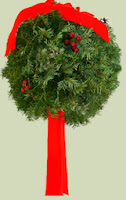Ever heard of the old-timey “Kissing Ball”? Crabapple LandscapExperts agree, holidays seem more
charming when fresh botanicals are used for decorations, and there’s no excuse
in our industry not to bring some evergreens indoors! Along with pine and
mistletoe, it’s traditional to deck the halls with boughs of holly and boxwood,
two evergreens that symbolize ‘constancy’ and ‘foresight’ in the Language of Flowers. While some “Kissing Balls” are made of needle-leaf evergreens, this winter try one made of boxwood and holly. Easy to make and with staying
power that lasts through New Years Day and beyond, a shoe box of 4-5 inch
clippings will make one kissing ball and will create the finish to a beautiful
holiday.
How to Make a Boxwood
& Holly Kissing Ball
Supplies:
Half a block of floral foam, well soaked in
water
Tight plastic mesh from bulb, grapefruit or
onion bags, dark color preferred
Spool of thin wire approximately 18 to 20
gauge
Clippers
About a shoebox full of 4-5 inch sprigs of Green
Borders Boxwood
About a dozen 4-5 inch clippings of Christmas
Jewel® Holly with berries
A few sprigs of mistletoe
Floral pick
Red Ribbon
Directions
- Soak the floral foam (one brand name is Oasis) thoroughly, then pare off the corners to make a rounded or ball shape about 5 inches across.
- Drain the floral foam and wrap the plastic mesh around it, enclosing the foam securely. Weave or stitch it together in a few places to hold it closed.
- Cut a 10-12 inch length of wire to make a hanger. Thread it through the center of the foam, creating a bend or U- shape to catch on the bottom side of the foam. Make a loop at the top for hanging.
- Clip enough 4-5 inch sprigs of boxwood and stick in the floral foam to cover the ball evenly and completely, making a uniform sphere of boxwood about 10 inches in diameter.
- Add berried stems of berried holly as an accent, again spacing evenly around the sphere. Your lush, full Kissing Ball of greenery is now ready for decorating.
- Wire a bit of mistletoe to a pick and insert at the bottom of the sphere.
- Add a red bow at the top and a tuft of short streamers to the bottom of the ball and hang it up!






































